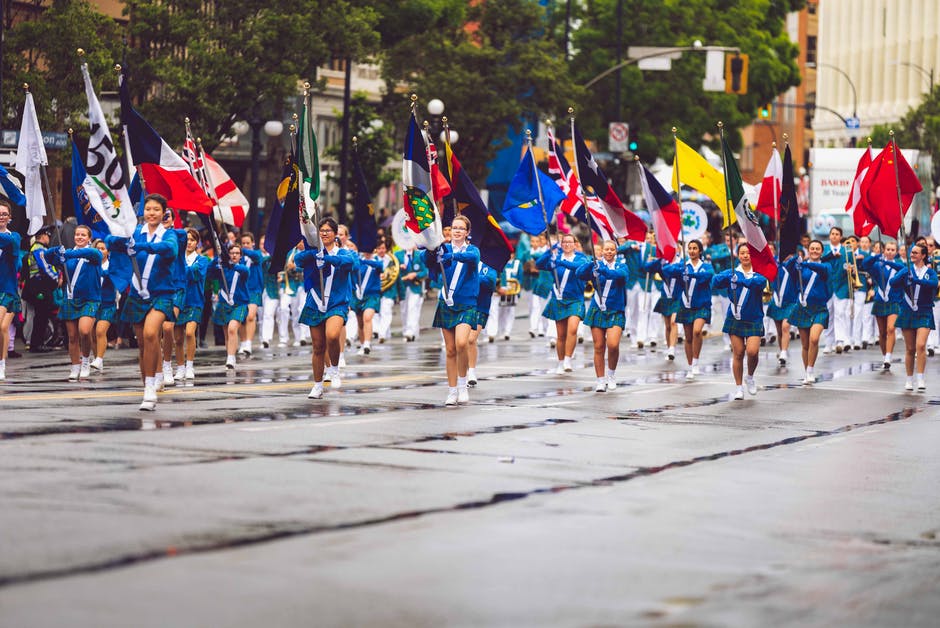
Everything You Need to Know About Color Guard Uniforms
Did you know that modern color guard was inspired by the practice of waving flags during the civil war? Nowadays, color guard is an activity that many high school and university students do for fun. Are you getting ready to join your school’s color guard team?
We’re here to talk about one of the most important parts of your color guard experience: the uniform. Read on to learn all about color guard uniforms!
The Basic Color Guard Uniform Components
There’s no one “right” way to have a color guard uniform. All schools, universities, and independent teams will have their own unique uniforms, and those uniforms may not even be consistent across everyone on the squad.
So what can you expect from yours? You won’t know for sure until you join the team, but overall, you’re either going to be wearing a one-piece or two-piece color guard outfit.
Most uniforms are two-piece uniforms. They come with a shirt and leggings, pants, or a skirt depending on the personal aesthetic of the team.
If the color guard team is co-ed, it’s possible for there to be both skirts and pants included depending on the gender or personal preference of the team member in question.
Some color guard teams wear one-piece costumes, though these are far less common. In this case, team members will be wearing body suits or leotards. Dresses are also an option, but they’re often paired with tights.
Material Details
It’s important for color guard uniforms to have two primary qualities. They need to be easy to move around in and eye-catching. These uniforms need to make an impact on the field or in a parade.
Because of this, picking the right material is everything.
Most color guard uniforms are made out of a nylon or spandex blend. This makes them flexible, making them great for performing tricks as well as running and dancing around the field.
Spandex and nylon are also stretchy enough for performers to toss and swing their color guard equipment without having to re-adjust the fabric.
When it comes to color, most of the time the colors are going to either fit the school or university that the team is a part of unless it’s an independent theme or a special show. If the color guard team uses flags, the material will also likely align with the flag colors.
There are often shiny and sparkly features on the material to make the uniforms more eye-catching under the bright field lights.
It’s also not uncommon to have things like sequins or decals on the color guard uniforms for some added “pizazz.”
Are Winter Uniforms and Summer Uniforms the Same?
This is going to vary depending on the team that you’re a part of.
If your color guard team belongs to a school or university in an area with a four-season climate, or if the team travels for holiday events, you’re likely going to have both a summer and winter uniform.
The summer uniforms are going to be thinner, lighter, and more breathable than their cold-weather counterparts. They’ll often be either short-sleeved or completely sleeveless, and if the base of the uniform is a dress or tunic, long leggings or pants may be replaced by shorts or thin tights.
Winter uniforms may use thicker materials, like velour. They’ll almost always have long sleeves and covered legs, though some teams may wear flesh-colored tights to mimic bare legs.
A tip for staying warm during winter performances: wear layers under your uniform if possible. Stockings and tights under color guard pants or leggings will make a huge difference. You can also tuck hand warmers into your shirt.
Are There Ever Special Color Guard Uniforms?
This isn’t true for every color guard team, but many teams will have special color guard uniforms for specific events or show themes! These uniforms are often more like costumes, and they may not fit the conventional “rules” of color guard uniforms.
For example, let’s say that your color guard is doing a show themed after the musical Chicago. The director may decide that the performers should wear outfits that resemble 1920s flapper outfits to fit the theme and put on a more theatrical performance.
If a team gets picked to do a more prestigious show such as the Macy’s Thanksgiving Day Parade, they may end up wearing special uniforms for the occasion.
What Accessories Are Included?
No color guard uniform is complete without accessories. All uniforms are different, so accessories will vary.
Most uniforms include gloves of some kind, even if they’re “armlets” or fingerless. Gloves are fantastic for gripping color guard equipment and, during the colder months, they’ll keep performers’ fingers warm.
Some uniforms include headbands or earmuffs for cooler weather. Some even include capes, though these are riskier for performers who swing flags.
When it comes to shoes, performers tend to wear plain black or white dance shoes, though this will vary.
What to Wear During Practice Sessions
During practice sessions, you won’t need to wear your uniform. Instead, wear something that you’d wear to the gym.
During warm weather practice sessions, shorts and a t-shirt with a pair of sneakers will make the perfect practice outfit. For colder weather seasons, thick leggings and a sweatshirt should be cozy enough without getting in your way too much.
Color Guard Uniforms Are All Different
There’s no one right way to construct color guard uniforms. Overall, they’re flashy and comfortable outfits that make an impact on the field and feel great to dance in.
What will your color guard uniform look like?
For more helpful articles about the top trending topics, visit the rest of the site.
